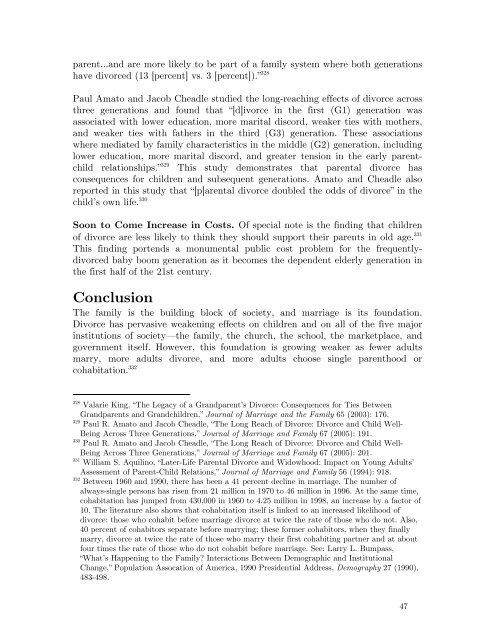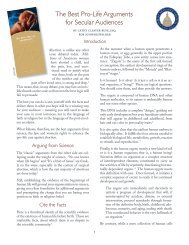The Effects of Divorce on Children - Family Research Council
The Effects of Divorce on Children - Family Research Council
The Effects of Divorce on Children - Family Research Council
Create successful ePaper yourself
Turn your PDF publications into a flip-book with our unique Google optimized e-Paper software.
parent…and are more likely to be part <str<strong>on</strong>g>of</str<strong>on</strong>g> a family system where both generati<strong>on</strong>s<br />
have divorced (13 [percent] vs. 3 [percent]).” 328<br />
Paul Amato and Jacob Cheadle studied the l<strong>on</strong>g-reaching effects <str<strong>on</strong>g>of</str<strong>on</strong>g> divorce across<br />
three generati<strong>on</strong>s and found that “[d]ivorce in the first (G1) generati<strong>on</strong> was<br />
associated with lower educati<strong>on</strong>, more marital discord, weaker ties with mothers,<br />
and weaker ties with fathers in the third (G3) generati<strong>on</strong>. <str<strong>on</strong>g>The</str<strong>on</strong>g>se associati<strong>on</strong>s<br />
where mediated by family characteristics in the middle (G2) generati<strong>on</strong>, including<br />
lower educati<strong>on</strong>, more marital discord, and greater tensi<strong>on</strong> in the early parentchild<br />
relati<strong>on</strong>ships.” 329 This study dem<strong>on</strong>strates that parental divorce has<br />
c<strong>on</strong>sequences for children and subsequent generati<strong>on</strong>s. Amato and Cheadle also<br />
reported in this study that “[p]arental divorce doubled the odds <str<strong>on</strong>g>of</str<strong>on</strong>g> divorce” in the<br />
child’s own life. 330<br />
So<strong>on</strong> to Come Increase in Costs. Of special note is the finding that children<br />
<str<strong>on</strong>g>of</str<strong>on</strong>g> divorce are less likely to think they should support their parents in old age. 331<br />
This finding portends a m<strong>on</strong>umental public cost problem for the frequentlydivorced<br />
baby boom generati<strong>on</strong> as it becomes the dependent elderly generati<strong>on</strong> in<br />
the first half <str<strong>on</strong>g>of</str<strong>on</strong>g> the 21st century.<br />
C<strong>on</strong>clusi<strong>on</strong><br />
<str<strong>on</strong>g>The</str<strong>on</strong>g> family is the building block <str<strong>on</strong>g>of</str<strong>on</strong>g> society, and marriage is its foundati<strong>on</strong>.<br />
<str<strong>on</strong>g>Divorce</str<strong>on</strong>g> has pervasive weakening effects <strong>on</strong> children and <strong>on</strong> all <str<strong>on</strong>g>of</str<strong>on</strong>g> the five major<br />
instituti<strong>on</strong>s <str<strong>on</strong>g>of</str<strong>on</strong>g> society—the family, the church, the school, the marketplace, and<br />
government itself. However, this foundati<strong>on</strong> is growing weaker as fewer adults<br />
marry, more adults divorce, and more adults choose single parenthood or<br />
cohabitati<strong>on</strong>. 332<br />
328 Valarie King, “<str<strong>on</strong>g>The</str<strong>on</strong>g> Legacy <str<strong>on</strong>g>of</str<strong>on</strong>g> a Grandparent’s <str<strong>on</strong>g>Divorce</str<strong>on</strong>g>: C<strong>on</strong>sequences for Ties Between<br />
Grandparents and Grandchildren,” Journal <str<strong>on</strong>g>of</str<strong>on</strong>g> Marriage and the <strong>Family</strong> 65 (2003): 176.<br />
329 Paul R. Amato and Jacob Cheadle, “<str<strong>on</strong>g>The</str<strong>on</strong>g> L<strong>on</strong>g Reach <str<strong>on</strong>g>of</str<strong>on</strong>g> <str<strong>on</strong>g>Divorce</str<strong>on</strong>g>: <str<strong>on</strong>g>Divorce</str<strong>on</strong>g> and Child Well-<br />
Being Across Three Generati<strong>on</strong>s,” Journal <str<strong>on</strong>g>of</str<strong>on</strong>g> Marriage and <strong>Family</strong> 67 (2005): 191.<br />
330 Paul R. Amato and Jacob Cheadle, “<str<strong>on</strong>g>The</str<strong>on</strong>g> L<strong>on</strong>g Reach <str<strong>on</strong>g>of</str<strong>on</strong>g> <str<strong>on</strong>g>Divorce</str<strong>on</strong>g>: <str<strong>on</strong>g>Divorce</str<strong>on</strong>g> and Child Well-<br />
Being Across Three Generati<strong>on</strong>s,” Journal <str<strong>on</strong>g>of</str<strong>on</strong>g> Marriage and <strong>Family</strong> 67 (2005): 201.<br />
331 William S. Aquilino, “Later-Life Parental <str<strong>on</strong>g>Divorce</str<strong>on</strong>g> and Widowhood: Impact <strong>on</strong> Young Adults’<br />
Assessment <str<strong>on</strong>g>of</str<strong>on</strong>g> Parent-Child Relati<strong>on</strong>s,” Journal <str<strong>on</strong>g>of</str<strong>on</strong>g> Marriage and <strong>Family</strong> 56 (1994): 918.<br />
332 Between 1960 and 1990, there has been a 41 percent decline in marriage. <str<strong>on</strong>g>The</str<strong>on</strong>g> number <str<strong>on</strong>g>of</str<strong>on</strong>g><br />
always-single pers<strong>on</strong>s has risen from 21 milli<strong>on</strong> in 1970 to 46 milli<strong>on</strong> in 1996. At the same time,<br />
cohabitati<strong>on</strong> has jumped from 430,000 in 1960 to 4.25 milli<strong>on</strong> in 1998, an increase by a factor <str<strong>on</strong>g>of</str<strong>on</strong>g><br />
10. <str<strong>on</strong>g>The</str<strong>on</strong>g> literature also shows that cohabitati<strong>on</strong> itself is linked to an increased likelihood <str<strong>on</strong>g>of</str<strong>on</strong>g><br />
divorce: those who cohabit before marriage divorce at twice the rate <str<strong>on</strong>g>of</str<strong>on</strong>g> those who do not. Also,<br />
40 percent <str<strong>on</strong>g>of</str<strong>on</strong>g> cohabitors separate before marrying; these former cohabitors, when they finally<br />
marry, divorce at twice the rate <str<strong>on</strong>g>of</str<strong>on</strong>g> those who marry their first cohabiting partner and at about<br />
four times the rate <str<strong>on</strong>g>of</str<strong>on</strong>g> those who do not cohabit before marriage. See: Larry L. Bumpass,<br />
“What’s Happening to the <strong>Family</strong>? Interacti<strong>on</strong>s Between Demographic and Instituti<strong>on</strong>al<br />
Change,” Populati<strong>on</strong> Assocati<strong>on</strong> <str<strong>on</strong>g>of</str<strong>on</strong>g> America, 1990 Presidential Address, Demography 27 (1990),<br />
483-498.<br />
47




